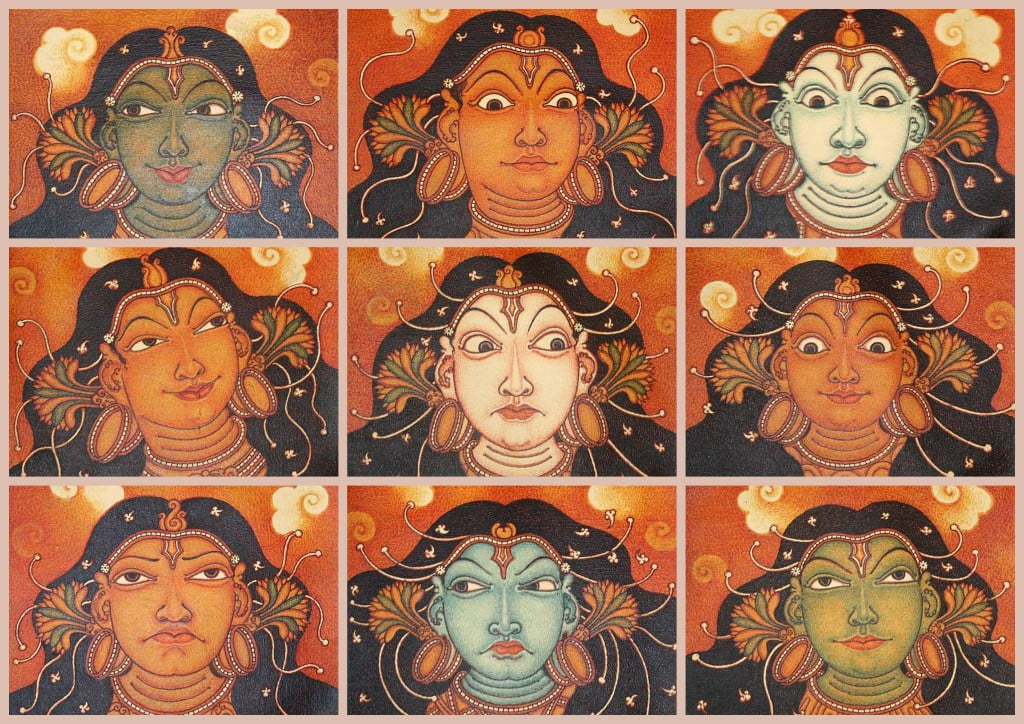THE CONCEPT OF NAVARASA FOR EMPOWERING OUR EMOTIONS
In Sanskrit Rasa means taste or essence and Nava means nine. Rasa is commonly used to denote the sense of an “emotional state.”
The nine Emotions included in Navarasa are Shringara (love), Hasya(laughter), Karuna(kind-heartedness or compassion), Raudra (anger), Veera (courage), Bhayanakara (terror), Bheebhatsya (disgust), Adbutha (surprise) and Shantha (peace or tranquility). These are the emotions that a human shows according to the situations.
Shringara: means “Love” and also “Beauty”. It denotes enjoying company of opposite sex. In English it means “Romance.” It is the foundation of man-woman relationship which brings warmth and security of a relationship. Loving and being loved adds richness to our lives. When people feel close to others they are happier and even healthier. Love helps us feel important, understood, and secured. Shringara implies that we must realize that beauty is everywhere and is always there to be loved.Sringara rasa is depicted by light green color.
Hasya: Hasya Rasa is an essential part of the life; what’s life without laughter? Hasya is of two kinds, Atmastha or self-based, Parastha or based in others. The Hasya Rasa is denoted by white colour. When we laugh at ourselves it is called Atmastha and when we make other laugh it is called Parastha. Laughter offers a number of positive organic effects on the human body. It strengthens immune system, reduces cravings and makes people more resistant to pain. Reduces the pressure, stress and increases the flexibility of muscles. The psychological and physical relaxation generated by laughter cannot be replaced by tons of money. It can draw our attention away from things that cause anger, guilt, stress and other negative Emotions. It allows us to see difficult situations with a new perspective.
Karuna: means Compassion which I would term as positive feeling. It isthe feeling of empathy for others in response to seeing their suffering; and a desire to help. Compassion when based on rational notions such as fairness, justice and interdependence is beautiful.The NatyaShastra states that the Karuna Rasa takes its origin through different Bhavas either at the sight of the death, murder, torture, or anguish. It is expressed as crying, speechlessness, sighs, expression of grief, loss of sense, weeping bitterly and other similar gestures. Karuna rasa is depicted in Grey color.
Rudra: In english its anger.It is one of the negative Emotions. There are two types of angers. The first being destructive anger and exists for the sake of itself. The second being constructive anger where it is born out of an injustice or dissatisfaction and a will to make a change towards a positive. Anger is a normal emotion with a wide range of intensity, from mild irritation and frustration to rage. It is a reaction to a perceived threat to us, our loved ones, our property, our self-image, or some part of our identity. Anger is a warning bell that tells us that something is wrong. Raudra Rasa and Karuna Rasa are similar as both can be the consequence of some deprivation. The outcome of deprivation in Karuna is loss of hope and resignation and in Raudra it is rage. Lord Shiva is famous for his “Rudravtar”. Rudra Rasa is portrayed in red color.
Veera: In English it is heroism. The Veera rasa is all about bravery, fearlessness, determination, boldness, self- confidence and grit. It is our willingness to venture out and do the right thing at the right time, despite the barriers we may encounter. Boldness enables us to speak the truth, and perform a task without fear of the consequences or results, because, it is the right, thing to do. Orange color depicts Veera rasa.
Bhayanaka: In English it is terror. The Bhayanaka Rasa depicts fear, worries, fretfulness and anxiety.Bhayanaka is a feeling evoked while facing something that is powerful than oneself, it’s a feeling of being helpless.The black color depicts bhayanaka rasa.
Beebhatsya: is disgust in English. Vulgar and uncivilized acts, usage of bad words and manners evoke an unpleasant feeling which is Beebhatshya.The feeling of disgust in the mind of Prince Siddhartha towards sickness, old age and death later transformed him into Buddha which is one of the avatars of Lord Vishnu. Blue is the color of Beebhatsya. It is a feeling of revulsion or strong disapproval aroused by something unpleasant or offensive. Disgust is a strong negative feeling of aversion or disapproval. Disgust is not just a physical sensation; it’s a powerful emotional warning sign.
Adbhuta: is amazement in English. Adbhuta is the rasa of curiosity, astonishment and wonder. The feeling when one comes across something divine and supernatural, something never seen or imagined before is Adbhuta. When we understand that there are things that we do not understand, it makes life beautiful and exciting, full of wonders to explore, full of opportunity for new understanding and personal growth. Wonder comes at the beginning of the spiritual journey, the journey to find real truth and solve the mystery of life. Life has much astonishment to offer. Adbhuta Rasa is depicted by yellow color.
Shanta: In English it is tranquility. Shanta is the rasa of tranquility and peace. It represents the state of calm and untroubled steadiness. Shanta represents complete harmony between the mind, body and universe. Shanta is what Buddha felt when he was enlightened that led him to salvation or nirvana which freed him from the cycle of life and death. The color of Shanta Rasa is white.

